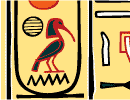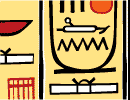The Temple of Horus at Edfu (Idfu)
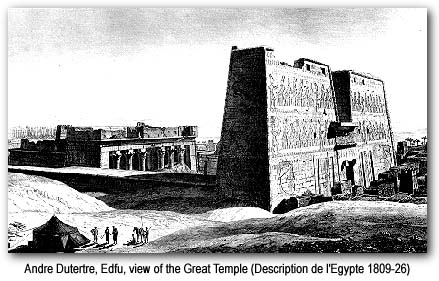 Dedicated to Horus, the falcon headed god, it was built during the reigns of six Ptolemies. We
have a great deal of information about its construction from reliefs on outer areas. It was
begun in 237 BC by Ptolemy III Euergetes I and was finished in 57 BC. Most of the work
continued throughout this period with a brief interlude of 20 years while there was unrest
during the period of Ptolemy IV and Ptolemy V Epiphanes. Dedicated to Horus, the falcon headed god, it was built during the reigns of six Ptolemies. We
have a great deal of information about its construction from reliefs on outer areas. It was
begun in 237 BC by Ptolemy III Euergetes I and was finished in 57 BC. Most of the work
continued throughout this period with a brief interlude of 20 years while there was unrest
during the period of Ptolemy IV and Ptolemy V Epiphanes.
This is not only the best preserved ancient temple in Egypt, but the second largest after
Karnak. It was believed that the temple was built on the site of the great battle between Horus
and Seth. Hence, the current temple was but the last in a long series of temples build on this
location. It is said that the original structure housing a statue of Horus was a grass hut built in
prehistoric times. At any rate, there is an earlier and smaller pylon of Ramesses II which sits in
a 90 degree angle to the current building.
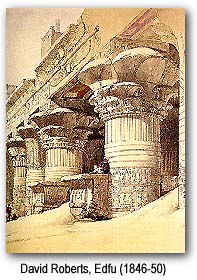 The main building, which includes a great Hypostyle Hall, was uncovered by Mariette in
the 1860s. There are numerous reliefs, including a depiction of the Feast of the Beautiful
Meeting, the annual reunion between Horus and his wife Hathor. The reliefs are mostly
situated on the inside of the first pylon, and spiritually connect this temple with Hathor’s
Temple at the Dendera complex. During the third month of summer, the priests at the Dendera
complex would place the statue of Hathor on her barque (a ceremonial barge) and would thus
bring the statue to the Edfu Temple, where it was believed that Horus and Hathor shared a
conjugal visit. Each night, the god and goddess would retire to the mamissi, or berthing house. The main building, which includes a great Hypostyle Hall, was uncovered by Mariette in
the 1860s. There are numerous reliefs, including a depiction of the Feast of the Beautiful
Meeting, the annual reunion between Horus and his wife Hathor. The reliefs are mostly
situated on the inside of the first pylon, and spiritually connect this temple with Hathor’s
Temple at the Dendera complex. During the third month of summer, the priests at the Dendera
complex would place the statue of Hathor on her barque (a ceremonial barge) and would thus
bring the statue to the Edfu Temple, where it was believed that Horus and Hathor shared a
conjugal visit. Each night, the god and goddess would retire to the mamissi, or berthing house.
There is still an entrance colonnade to the mamissi, and reliefs with considerable remaining
color just outside the main temple. These images portray the ritual of the birth of Harsomtus,
son of Horus and Hathor.
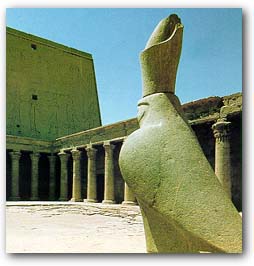 The pylons of the main Temple are about 118 feet high with typical scenes of the pharaoh in
battle with his enemies. Within the pylons is the colonnaded courtyard with distinctive, pared
columns, which leads into the great hypostyle hall. But on either side of the courtyard there are
gates which lead to an area behind the temple and inside the bounding walls. Here, there are
inscriptions recording donations of land which were probably transferred from demotic
documents. There are also dramatic images depicting the defeat of Seth by Horus. There was
an annual ritual called the known as the Triumph of Horus (10 harpoons) which ended in the
slaying of a hippopotamus, the symbol of Seth. The pylons of the main Temple are about 118 feet high with typical scenes of the pharaoh in
battle with his enemies. Within the pylons is the colonnaded courtyard with distinctive, pared
columns, which leads into the great hypostyle hall. But on either side of the courtyard there are
gates which lead to an area behind the temple and inside the bounding walls. Here, there are
inscriptions recording donations of land which were probably transferred from demotic
documents. There are also dramatic images depicting the defeat of Seth by Horus. There was
an annual ritual called the known as the Triumph of Horus (10 harpoons) which ended in the
slaying of a hippopotamus, the symbol of Seth.
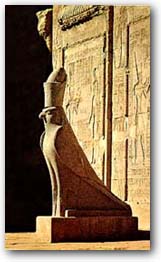 The facade of the first hypostyle hall has images honoring Horus and Hathor, and there
is an immaculate ten foot tall colossi of Horus as the falcon god here (a matching colossi
is was destroyed). As you enter the great hall, you will begin to notice the use of light Even
though the temple was build over hundreds of years, it is very harmonious, and ebbs and flow
of lighting was certainly purposeful, portraying a feeling of mystery. Just inside the hall are two
small rooms, a robing room on the west and a library to the east where the priest would obtain
the religious orders of the day. Within this hall are scenes of offering including the temple
foundation ceremonies. The facade of the first hypostyle hall has images honoring Horus and Hathor, and there
is an immaculate ten foot tall colossi of Horus as the falcon god here (a matching colossi
is was destroyed). As you enter the great hall, you will begin to notice the use of light Even
though the temple was build over hundreds of years, it is very harmonious, and ebbs and flow
of lighting was certainly purposeful, portraying a feeling of mystery. Just inside the hall are two
small rooms, a robing room on the west and a library to the east where the priest would obtain
the religious orders of the day. Within this hall are scenes of offering including the temple
foundation ceremonies.
Beyond the great hypostyle hall is a second, smaller hypostyle hall which leads to a well called
the Chamber of the Nile where the Priests obtained pure holy water. This is a similar
arrangement as found at Dendera. On the west side of the room are doors that lead to a small
laboratory with recipes engraved on the walls for ointments and perfumes which where used
daily to anoint the statue of Horus, and to a treasure room where offerings were stored.
Beyond the second hypostyle hall is the offering hall, followed by the vestibule and finally the
sanctuary. There is a granite naos here dedicated by Nectanebo II, making it the oldest relic in
the temple. It is probable that a golden gilded wooden statue of Horus about 60 cm tall would
have resided on the naos. This statue would have been cared for by the priests in a human
manner, being washed, dressed, anointed, fed and entertained.
The sanctuary itself is surrounded by chapels and rooms which, when facing north and in
clockwise order, are the chapel of Min, the chamber of linen where the robs of the Horus
would have been stored, the chamber of the throne of gods, the chamber of Osiris, the
chamber of the West, the tomb of Osiris, the chamber of the victor (Horus), where there is a
reconstructed ceremonial barge (barque), chapels of Khonsu and Hathor, the chapel of the
throne of Re and a chapel of the spread wings, dedicated principally to Mehit, the lioness who
guarded the path the soul passed on its journey towards resurrection. The front chapel on the
east is the Chapel of the New Year, a sun court like that at Dendera. Here, a depiction on the
ceiling show the voyage of the solar barque through the Twelve Hours of the day, with an
inspiring image of the goddess, Nut. The statue of Horus would be taken from here up a flight
of stairs to the roof terrace where it would be recharged by the sun during the Festival of the
New Year. The walls of the stairs located in the outer anti-chamber depict this ritual.
|
